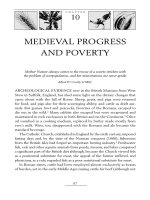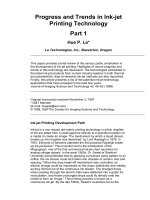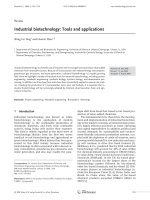Microbial biotechnology progress and trends
Bạn đang xem bản rút gọn của tài liệu. Xem và tải ngay bản đầy đủ của tài liệu tại đây (7.69 MB, 302 trang )
Hideharu Anazawa
Sakayu Shimizu Editors
Microbial
Production
From Genome Design to Cell Engineering
Tai Lieu Chat Luong
Microbial Production
Hideharu Anazawa • Sakayu Shimizu
Editors
Microbial Production
From Genome Design to Cell Engineering
Editors
Hideharu Anazawa, Ph.D.
Director
Japan Bioindustry Association
Grande Bldg. 8F, 2-26-9 Hatchobori, Chuo-ku
Tokyo 104-0032, Japan
Sakayu Shimizu, Ph.D.
Professor
Department of Bioscience and Biotechnology
Graduate School of Enviromental Science
Kyoto Gakuen University
Nanjo-Ohtani, Sogabe, Kameoka
Kyoto 621-8555, Japan
ISBN 978-4-431-54606-1
ISBN 978-4-431-54607-8 (eBook)
DOI 10.1007/978-4-431-54607-8
Springer Tokyo Heidelberg New York Dordrecht London
Library of Congress Control Number: 2013956366
© Springer Japan 2014
This work is subject to copyright. All rights are reserved by the Publisher, whether the whole or part of
the material is concerned, specifically the rights of translation, reprinting, reuse of illustrations, recitation,
broadcasting, reproduction on microfilms or in any other physical way, and transmission or information
storage and retrieval, electronic adaptation, computer software, or by similar or dissimilar methodology
now known or hereafter developed. Exempted from this legal reservation are brief excerpts in connection
with reviews or scholarly analysis or material supplied specifically for the purpose of being entered and
executed on a computer system, for exclusive use by the purchaser of the work. Duplication of this
publication or parts thereof is permitted only under the provisions of the Copyright Law of the Publisher’s
location, in its current version, and permission for use must always be obtained from Springer.
Permissions for use may be obtained through RightsLink at the Copyright Clearance Center. Violations
are liable to prosecution under the respective Copyright Law.
The use of general descriptive names, registered names, trademarks, service marks, etc. in this publication
does not imply, even in the absence of a specific statement, that such names are exempt from the relevant
protective laws and regulations and therefore free for general use.
While the advice and information in this book are believed to be true and accurate at the date of
publication, neither the authors nor the editors nor the publisher can accept any legal responsibility for
any errors or omissions that may be made. The publisher makes no warranty, express or implied, with
respect to the material contained herein.
Printed on acid-free paper
Springer is part of Springer Science+Business Media (www.springer.com)
Preface
It has long been considered essential to introduce energy-saving and environmentally
friendly bioprocesses to incorporate resource-saving concepts in production systems. Production of useful substances using microbial and enzymatic reactions, for
example, is a truly environmentally friendly process and should be actively explored
if there is even a small possibility for the process to replace a chemical-industrial
one based on conventional petrochemical reactions.
Historically speaking, the microbial production of useful substances has shown
expansion of its fundamental and technological platforms and evolved in a unique
manner, mainly through fermentative or enzymatic transformation of bioactive
compounds such as antibiotics, amino acids, nucleic acid-related compounds, and
vitamins. There have been some relatively recent developments in technologically
and industrially new areas, such as the production of chiral chemicals using chemoenzymatic methods, the production of commodity chemicals (e.g., acrylamide,
ethanol, isopropanol, and n-butanol), and single-cell oil production.
Many of the technologies originated in Japan and have made prominent contributions to mankind. One of the bases of these developments has been established
through extensive screening using the rich and diverse microbial resources of Japan,
a country that has been one of the major players in the establishment and development of scientific and technological platforms.
As already mentioned, a bioprocess, especially a microbial one, is essentially
environmentally friendly. However, there are many unresolved issues related to
energy savings and resource depletion. Is CO2 reduction really possible by introducing biosystems in place of petrochemical systems? Are biosystems really clean? At
this time, unfortunately, we still do not have enough data, concrete evidence, and
in-depth discussions about these issues. What are always referred to are the cases of
the nitrile hydratase process for acrylamide production and the lactonase process for
pantothenate production. In each instance, it is evident that the overall process is
simple and rapid, and requires less energy (30 % CO2 reduction compared with
conventional chemical processes). Undoubtedly, this tendency can be found in
many of the processes already in use, but to our regret, no relevant data have been
presented to society.
v
vi
Preface
According to a report from the Department of Trade and Industries in the UK,
Japan’s strength in this area of biotechnology lies in the fact that chemical industries
have been actively promoting the industrialization of bioprocesses with the use of
their rich microbial resources and have incorporated their technologies into their
industrial structures. However, I believe that these facts may not, in themselves, be
obvious in Japan, or may already be self-evident and allow no room for further
debate, which could be why there are not many active discussions about these matters now. Am I the only person who has the impression that all relevant political
actions at the national level supporting this biotechnology are also inadequate?
Many of the chapters collected here are based on the results of the work for the
decade-long METI/NEDO project, the so-called Minimum Genome Factory, in
which I was involved as a project leader.
Kyoto, Japan
Sakayu Shimizu
Contents
Part I
1
Minimum Genome Factory
Creation of Novel Technologies for Extracellular
Protein Production Toward the Development
of Bacillus subtilis Genome Factories ....................................................
Katsutoshi Ara, Kenji Manabe, Shenghao Liu,
Yasushi Kageyama, Tadahiro Ozawa, Masatoshi Tohata,
Keiji Endo, Kazuhisa Sawada, Nozomu Shibata,
Akihito Kawahara, Kazuhiro Saito, Hiroshi Kodama,
Yoshiharu Kimura, Katsuya Ozaki, Yoshinori Takema,
Hiroshi Kakeshita, Kouji Nakamura, Kunio Yamane,
Takeko Kodama, Junichi Sekiguchi, Takuya Morimoto,
Ryosuke Kadoya, Shigehiko Kanaya, Yasutaro Fujita,
Fujio Kawamura, and Naotake Ogasawara
3
2
Minimum Genome Factories in Schizosaccharomyces pombe.............
Hiromichi Kumagai, Mayumi Sasaki, Alimjan Idiris,
and Hideki Tohda
17
3
The Concept of the Escherichia coli Minimum Genome Factory.......
Hideharu Anazawa
25
Part II Whole Genome Manipulation for Genome Design
4
5
Efficient and Accurate Production
of De Novo Designed Large-Size Gene Clusters
by a Novel Bacillus subtilis-Based System ............................................
Mitsuhiro Itaya, Shinya Kaneko, and Kenji Tsuge
Development and Application of Novel Genome
Engineering Technologies in Saccharomyces cerevisiae .......................
Yu Sasano, Minetaka Sugiyama, and Satoshi Harashima
35
53
vii
viii
6
Contents
Genome Design of Actinomycetes for Secondary Metabolism............
Kiyoko T. Miyamoto and Haruo Ikeda
63
Part III Application of Omics Information and Construction
of Mutant Libraries
7
Application Methodology of Whole Omics Information .....................
Myco Umemura and Masayuki Machida
8
Application of Genomics in Molecular Breeding
of the koji Molds Aspergillus oryzae and Aspergillus sojae ..................
Tadashi Takahashi
9
10
Comprehensive Libraries of Escherichia coli K-12
and Their Application .............................................................................
Hirotada Mori, Rikiya Takeuchi, Yuta Otsuka, Yong Han Tek,
Wataru Nomura, and Barry L. Wanner
75
87
97
Insights into Metabolism and the Galactose Recognition
System from Microarray Analysis in the Fission Yeast
Schizosaccharomyces pombe ................................................................... 109
Kaoru Takegawa and Tomohiko Matsuzawa
Part IV Applications of Advanced Technologies for Production
11
Multi-enzymatic Systems for the Production
of Chiral Compounds ............................................................................. 121
Akira Iwasaki, Noriyuki Ito, and Yoshihiko Yasohara
12
Use of Organic Solvent-Tolerant Microorganisms
in Bioconversion ...................................................................................... 131
Akinobu Matsuyama
13
Approaches for Improving Protein Production
by Cell Surface Engineering .................................................................. 141
Takeko Kodama, Kenji Manabe, Katsutoshi Ara,
and Junichi Sekiguchi
14
Strategies for Increasing the Production Level
of Heterologous Proteins in Aspergillus oryzae ..................................... 149
Mizuki Tanaka and Katsuya Gomi
15
Overproduction of L-Glutamate in Corynebacterium glutamicum...... 165
Hisashi Yasueda
Contents
ix
Part V Pharmaceuticals
16
Microbial Hormones as a Master Switch for Secondary
Metabolism in Streptomyces ................................................................... 179
Takeaki Tezuka and Yasuo Ohnishi
17
Enzymatic Production of Designed Peptide.......................................... 191
Kuniki Kino
Part VI Functional Foods
18
Microbial Production of Functional Polyunsaturated
Fatty Acids and Their Derivatives ......................................................... 207
Jun Ogawa, Eiji Sakuradani, Shigenobu Kishino, Akinori Ando,
Kenzo Yokozeki, and Sakayu Shimizu
19
Enzymatic Production of Oligosaccharides .......................................... 219
Takashi Kuroiwa
Part VII
Cosmetics
20
Cosmetic Ingredients Fermented by Lactic Acid Bacteria.................. 233
Naoki Izawa and Toshiro Sone
21
Structure of Tyrosinase and Its Inhibitor from Sake Lees .................. 243
Yasuyuki Matoba and Masanori Sugiyama
Part VIII
Energy and Chemicals
22
Toward Realization of New Biorefinery Industries Using
Corynebacterium glutamicum ................................................................. 253
Haruhiko Teramoto, Masayuki Inui, and Hideaki Yukawa
23
Hydrogen Production Using Photosynthetic Bacteria ......................... 263
Jun Miyake
24
Production of Biofuels and Useful Materials by Anaerobic
Organisms in Ecosystem of Methane Fermentation ............................ 283
Yutaka Nakashimada and Naomichi Nishio
Index ................................................................................................................. 301
Part I
Minimum Genome Factory
Chapter 1
Creation of Novel Technologies for Extracellular
Protein Production Toward the Development
of Bacillus subtilis Genome Factories
Katsutoshi Ara, Kenji Manabe, Shenghao Liu, Yasushi Kageyama,
Tadahiro Ozawa, Masatoshi Tohata, Keiji Endo, Kazuhisa Sawada,
Nozomu Shibata, Akihito Kawahara, Kazuhiro Saito, Hiroshi Kodama,
Yoshiharu Kimura, Katsuya Ozaki, Yoshinori Takema, Hiroshi Kakeshita,
Kouji Nakamura, Kunio Yamane, Takeko Kodama, Junichi Sekiguchi,
Takuya Morimoto, Ryosuke Kadoya, Shigehiko Kanaya, Yasutaro Fujita,
Fujio Kawamura, and Naotake Ogasawara
Abstract Bacillus subtilis has been widely used for the industrial production of
useful proteins because of its high protein secretion ability and safety. We focused on
genome reduction as a new concept for enhancing production of recombinant
enzymes in B. subtilis cells based on detailed analysis of the genome mechanism.
First, we reported that a novel B. subtilis strain, MGB874, depleted 20.7 % of the
genomic sequence of the wild type by rationally designed deletions to create simplified cells for protein production. When compared with wild-type cells, the productivity of cellulase and protease from transformed plasmids harboring the corresponding
genes was markedly enhanced. These results indicate that a bacterial factory specializing in the production of substances can be constructed by deleting the genomic
regions unimportant for growth and substance production from B. subtilis. Second,
deletion of the rocDEF-rocR region, which is involved in arginine degradation, was
found to contribute to the improvement of enzyme production in strain MGB874.
K. Ara (*)
Integrated Medical Research Laboratories, Kao (China) Research &
Development Center Co., Ltd, Shanghai, China
Biological Science Laboratories, Kao Corp, Tochigi, Japan
e-mail:
K. Manabe • S. Liu • Y. Kageyama • T. Ozawa • M. Tohata • K. Endo • K. Sawada
N. Shibata • A. Kawahara • K. Saito • H. Kodama • Y. Kimura • K. Ozaki • Y. Takema
Biological Science Laboratories, Kao Corp, Tochigi, Japan
H. Kakeshita
Biological Science Laboratories, Kao Corp, Tochigi, Japan
Graduate School of Life and Environmental Sciences, University of Tsukuba, Tsukuba, Japan
K. Nakamura • K. Yamane
Graduate School of Life and Environmental Sciences, University of Tsukuba, Tsukuba, Japan
H. Anazawa and S. Shimizu (eds.), Microbial Production: From Genome Design
to Cell Engineering, DOI 10.1007/978-4-431-54607-8_1, © Springer Japan 2014
3
4
K. Ara et al.
The present study indicated that our results demonstrated the effectiveness of a
synthetic genomic approach with reduction of genome size to generate novel and
useful bacteria for industrial uses. Furthermore, the design of the changes in the
transcriptional regulatory network of the nitrogen metabolic pathway in B. subtilis
cells could facilitate the generation of improved industrial protein production.
Keywords Bacillus subtilis • Recombinant protein productivity • Refined genome
factory
1.1
Introduction
Bacillus subtilis (B. subtilis), a gram-positive soporiferous bacillus, has been widely
used for the industrial production of useful proteins because of its high protein
secretion ability and safety (Simonen and Palva 1993). Beginning about 1990,
mainly European and Japanese research groups implemented a project to sequence
the entire B. subtilis strain 168 genome, and reported the sequence of the entire
4,215-kbp genome in 1997 (Kunst et al. 1997). At that time, they reported 4,101
genes in the entire genome and identified or inferred the functions of 58 % of these
genes. A subsequent project to analyze the functions of the unknown genes identified the functions of about half of the functionally unknown genes. In addition, the
individual disruption of 4,101 genes of B. subtilis showed that 271 genes (essential
genes) were absolutely essential for growth, and the majority was involved in DNA
replication, gene transcription and translation, cell structure formation, and cell
division (Schumann et al. 2000; Kobayashi et al. 2003).
Deleting genes unnecessary for the production and secretion of useful proteins
from the B. subtilis 168 strain and introducing necessary genes to improve the B. subtilis genome, we aimed to create a host microorganism cell (MGF) that can efficiently
T. Kodama
Biological Science Laboratories, Kao Corp, Tochigi, Japan
Faculty of Textile Science and Technology, University of Shinshu, Matsumoto, Japan
J. Sekiguchi
Faculty of Textile Science and Technology, University of Shinshu, Matsumoto, Japan
T. Morimoto • R. Kadoya
Graduate School of Information Science, Nara Institute of Science and Technology, Ikoma, Japan
Biological Science Laboratories, Kao Corp, Tochigi, Japan
S. Kanaya • N. Ogasawara
Graduate School of Information Science, Nara Institute of Science and Technology, Ikoma, Japan
Y. Fujita
Faculty of Life Science and Biotechnology, Fukuyama University, Fukuyama, Japan
F. Kawamura
Laboratory of Molecular Genetics, Rikkyo University, Tokyo, Japan
1
Creation of Novel Technologies for Extracellular…
5
produce commercial enzymes promising for application in a wide range of production
processes. The number of essential genes required for the growth of eukaryotic bacteria is expected to be about 300–500, regardless of the genus and species, and the
majority of genomes consist of nonessential genes, which can probably be deleted
from the chromosome without influencing growth. Westers et al. deleted two prophage regions (SP* and PBSX), three prophage-like regions (prophage 1, prophage 3,
and skin), and the largest operon pks from the B. subtilis genome, thereby constructing
a sextuple-deletion strain lacking 332 genes, accounting for 7.7 % of the entire
genome (Westers et al. 2003). In this sextuple-deletion strain, the deletion of regions
was found not to influence the growth of B. subtilis, protein secretion, transformation
competence, or sporulation ability, indicating that the genome of B. subtilis can be
artificially reduced by deleting nonessential gene regions.
We expected that it would be possible to construct a database for determination
of the minimum set of genes in B. subtilis by efficiently deleting these regions. In
addition, it is interesting to know whether the deletion of a large genomic region
influences the production of useful enzymes and cell growth. We previously
attempted to delete regions of more than 10 kbp present in essential genes, and successfully constructed a strain (MGF874) with a reduced genome, with deletions of
866 genes accounting for 20.7 % (about 874 kbp) of the B. subtilis genome, which
was similar in morphology and growth to the wild strain. Moreover, a genomereducing strain (B. subtilis strain RGB1334) was constructed from B. subtilis
MGB874 by deletion of 27 gene regions, which resulted in a 20 % increase of cellulose productivity in the later growth phase when compared to B. subtilis MGB874
(Ara et al. 2007; Morimoto et al. 2008; Kageyama et al. 2009). These results indicate that a bacterial factory specializing in the production of substances can be
constructed by deleting the genomic regions unimportant for growth and substance
production from B. subtilis. Furthermore, based on detailed analysis of the genome
mechanism (Kobayashi et al. 2012), the design of the amino-acid metabolism of a
B. subtilis (Manabe et al. 2011, 2012), improvement of secretion equipment
(Kakeshita et al. 2010, 2011a, b, c), a high translation system of a target gene
(Tagami et al. 2012), and cell surface engineering (see Chap. 15; Kodama et al.
2007a; Kodama et al. 2007b; Kodama et al. 2011), etc., were implemented.
1.2
Genome Reduction in B. subtilis
Strategies for genome reduction, which represents a relatively new field in synthetic
genomics, have been used with Escherichia coli and B. subtilis to investigate microbial genomic architecture and improve their characteristics (Westers et al. 2003;
Posfai et al. 2006; Mizoguchi et al. 2007, 2008; Fabret et al. 2002). For effective
production of enzymes, we have been performing a study aiming at the creation of
B. subtilis MGF, by deleting genes that are not essential under normal cultivating
conditions, and enhancing essential genes. Single deletion of each of a number of
genes and multiple deletions of dozens of genomic regions were carried out efficiently by using different deletion techniques.
6
1.2.1
K. Ara et al.
Genome Deletion Technology
A genetic tool to introduce marker-free deletions is essential for multiple manipulations of genomes (Liu et al. 2007). We reduced the B. subtilis genome by step-bystep deletion, using the upp (encoding uracil-phosphoribosyltransferase) cassette
and 5-fluorouracil (5-FU) selection (Fabret et al. 2002), to select cells that had lost
a drug-resistant cassette used to introduce primary deletions through intramolecular
homologous recombination at repeated sequences flanking the cassette (Morimoto
et al. 2008) (Fig. 1.1a). We also developed a system using the AraR repressor to
improve the efficiency at which marker-free mutants can be obtained (Liu et al.
2008). In this method, we replaced the native araR gene with a promoter-less neomycin resistance gene (neo) fused to the arabinose operon (ara) promoter, and the
selection marker cassette containing a chloramphenicol resistance gene and the
araR gene encoding the repressor for the ara operon was then integrated into the
target site. Transformants became neomycin sensitive after integration of the marker
cassette because of the repression of neo expression by AraR, and marker cassettefree cells were obtained by selection for neomycin resistance. However, the methods just described require the use of specific genetic backgrounds, such as
inactivation of the native upp gene for 5-FU selection, or replacement of the araR
gene with the Para-neo construct in the latter system (Liu et al. 2008). We developed a simple and efficient method to create marker-free deletion mutants of B.
subtilis through transformation with recombinant PCR products, using the E. coli
mazF gene encoding an endoribonuclease that cleaves free mRNAs as a counterselection tool (Morimoto et al. 2009, 2011a, b).
The mazF-encoding cassette is fused with the flanking sequences of the target
region using splicing by overlap extension-polymerase chain reaction (SOE-PCR).
Upstream and downstream sequences (fragments A and B) of the flanking region to
be deleted are amplified from the genomic DNA of the B. subtilis strain to be manipulated. The mazF cassette is amplified from the genomic DNA of B. subtilis strains
that contain a drug resistance gene and the mazF gene under the control of an isopropyl β-D-1-thiogzalactopyranoside (IPTG)-inducible spac promoter (Fig. 1.1b).
An internal sequence (fragment C) in the target region is also amplified. These PCR
products are fused by recombinant PCR in the order A–B–mazF-cassette–C (as
illustrated in Fig. 1.1) and integrated into the target region through homologous
recombination between fragment A and C loci. The resulting recombinants are
selected for drug resistance in the absence of IPTG. Thereafter, the primary transformant is cultivated in the presence of IPTG (i.e., mazF toxin-inducing conditions),
and clones in which the mazF cassette has been excised by intramolecular homologous recombination at region B are selected (Fig. 1.1b).
1.2.2
Multiple Deletion Design for MGF
To construct the multiple deletion series mutants, we rationally designed to maintain
cellular function for recombinant protein production. Among 4,106 genes in the
1
Creation of Novel Technologies for Extracellular…
7
Fig. 1.1 Method to introduce marker-free deletions in the Bacillus subtilis genome. a A derivative
of B. subtilis 168, 168 Δupp, in which the upp gene encoding uracil-phosphoribosyl transferase is
inactivated by replacement with the erythromycin resistance gene (erm), was used as the starting
strain for generation of the deletion mutant series. The entire length of the tetracycline-resistant
gene (tet) cassette with its 5′-regulatory region was amplified from the pBEST307 plasmid. At
least 500 bp of sequences flanking both sides of the region to be deleted were amplified by PCR,
and joined upstream and downstream of the tet cassette by ligation using overlapping sequences in
primers. The B. subtilis 168 Δupp strain and its derivatives were transformed with the resultant
fragment to obtain a strain in which the target sequence was replaced with the tet gene. Next, to
obtain marker-less mutants, fragments upstream and downstream of the target sequence were
amplified, ligated, and cloned into the pBRcat/upp plasmid harboring the upp and chloramphenicol
resistance (cat) gene. The resultant plasmid was integrated into the genome of the primary transformant with selection for tetracycline and chloramphenicol resistance. The resultant strain became
5-fluorouracil (5-FU) sensitive as a result of introduction of the functional upp gene, and mutants
without the plasmid sequence were selected on LB plates containing 10 μM 5-FU. b Development
of a new simple method to introduce marker-free deletions. Upstream (fragment A), downstream
(fragment B) of the target region for deletion, and the first homologous recombination sequence
(fragment C) were amplified by PCR from the chromosomal DNA of B. subtilis. By using the
chromosomal DNA of the strain TMO310 (168, aprE::specR, lacI, Pspac-mazF) or TMO311 (168,
aprE::KmR, lacI, Pspac-mazF) as a template, a DNA fragment was amplified by PCR as MazF
cassette. Using the thus-obtained PCR fragments, i.e., the MazF cassette, fragment A, fragment B,
and fragment C, recombinant PCR was performed. As a result, a DNA fragment that has fragment
A, fragment B, MazF cassette, and fragment C, aligned in that order, was obtained. B. subtilis 168
was transformed with this PCR product according to the competent cell transformation method.
The transformants were selected on a LB medium plate containing 100 μg/ml spectinomycin or
5 μg/ml kanamycin overnight at 37 °C. The transformant having spectinomycin resistance or kanamycin resistance was cultured overnight in LB liquid medium. After dilution of the culture, the
culture solution was applied on a LB medium plate supplemented with 1 mM isopropyl β-d-1thiogalactopyranoside (IPTG). These colonies growing on IPTG-containing LB medium plate are
the B. subtilis transformants in which the target region for deletion and MazF cassette were both
popped out from the host chromosome DNA
genome of the B. subtilis 168 strain, 271 genes were reported to be essential for cellular maintenance and growth (Kobayashi et al. 2003). We initially identified contiguous genome sequences greater than 10 kb that did not code for RNA or essential
proteins (Morimoto et al. 2008). In addition, we excluded all known and possible
8
K. Ara et al.
genes involved in primary metabolism to maintain growth in minimal medium, as
well as those related to DNA metabolism to avoid genome instability (Morimoto
et al. 2008). We also evaluated the production of the cellulase protease and amylase
using about 3,000 single gene deletion mutants of the B. subtilis 168 to consider the
effects of each gene on extracellular protein production (Ara et al. 2007). We identified 116 genes of which deletion enhanced the secretory protein production and 96
genes of which deletion suppressed the secretory protein production (Ara et al.
2007). Based on the result, we designed the deletion regions and performed step-bystep deletions from the genome of wild-type cells (Morimoto et al. 2008).
1.3
Enhanced Recombinant Protein Productivity in
MGB874
By step-by-step deletions in regions where single deletions did not affect cell growth,
we construct a reduced genome B. subtilis strain. Accordingly, sequential deletions
in 23 nonessential gene clusters were introduced in B. subtilis 168 to generate
MGB874, depleted of 874 kb (20.7 %) of the sequence including 865 genes from the
original B. subtilis 168 genome (Fig. 1.2a). Although the growth rate of MGB874
cells was reduced compared with the wild-type 168 strain, cell morphology and
chromosome distribution were normal (Fig. 1.2b). The reduced growth rate indicates
Fig. 1.2 Design and cell morphologies of MGB874. a Outer concentric ring: genome coordinate
(bases) of the B. subtilis 168 genome. Ring 2 (green): positions of deleted sequences in MGB874,
including prophages and prophage-like regions (SPβ, PBSX, skin, pro1-7), and polyketide and
plipastatin synthesis operons (pks, pps). Rings 3 and 4 (blue): protein-coding regions in clockwise
(Ring 3) and counterclockwise (Ring 4) orientations. Ring 5: GC contents. b Cell morphology,
chromosome distribution, and mean values of cell lengths of wild-type 168 and MGB874 cells.
MGB874 and 168 cells were cultured at 37 °C in LB or SMM medium, and images were obtained
during the exponential growth phase after staining with 4,6-diamindino-2-phenylindole (DAPI).
The average cell length is indicated (~200 cells analyzed)
1
Creation of Novel Technologies for Extracellular…
9
Fig. 1.3 Productivity of extracellular enzymes by the multiple-deletion series strains. a Growth
profiles of wild-type 168 (open diamonds) and MGB874 (closed squares). Arrows with a–e indicate times of cell collection for transcriptome analysis. b Relative activities of cellulase Egl237
(black bars) and M-protease (white bars) in growth medium of the multiple-deletion series, compared to those of the wild-type 168 strain after 75 h cultivation in 2xL-Mal medium, are indicated
with error bars (average of three experiments). c Cellulase production as a function of cell growth.
Extracellular cellulase activities of wild-type 168 (white bars) and MGB874 (black bars) cultures
(0.4 μl). d Consumption of sugars in the growth medium. Wild-type 168 (open diamonds) and
MGB874 (closed squares) cultures were collected at the indicated times
that certain nonannotated and deleted genes contribute to the metabolic capacity of
B. subtilis cells under normal growth conditions. It is also possible that this
phenotype is caused by unexpected synergetic effects of the deletions of genes.
To assess the productivity of MGB874 cells in terms of exogenous protein secretion, we examined the production of thermostable alkaline cellulase, Egl237
(Hakamada et al. 2000), and alkaline protease (M-protease) (Kobayashi et al. 1995)
from a multicopy plasmid. We introduced these plasmids into the multiple deletion
series strains and measured the protease and cellulase activities after 75 h culture in
2xL-Mal, a model medium for industrial protein production, respectively (Morimoto
et al. 2008) (Fig. 1.3a). Unexpectedly, the production of both enzymes increased in
proportion to genome deletion lengths, with maximum levels estimated in the
MGB874 strain (Fig. 1.3b). The activities of cellulase and protease in the culture
medium of MGB874 cells were about 1.7- and 2.5 fold higher than those from wildtype cells, respectively (Fig. 1.3b). Increase in cell mass was similar for MGB874
10
K. Ara et al.
Fig. 1.4 Determination of the deletion contributing to enhanced enzyme production. The pdprocR region was deleted from MGB625 to construct MGB723. Systematic inactivations were carried out to narrow the range of region responsible for elevating the enzyme production level. a The
pdp-rocR region (98,188 bp) corresponding to 4,048,987–4,147,174 bp in the genome of B. subtilis
168. The pdp-rocR region (16,636 bp) corresponding to 4,130,538–4,147,174 bp in the genome of
B. subtilis 168. b Cellulase activities in the growth media of B. subtilis derivative strains harboring
pHYS237 for Egl-237 production. c Protease activities in the growth media of B. subtilis derivative
strains harboring pHP237-K16 for M-protease production. Cells were precultured in LB medium
containing 15 μg ml−1 Tet at 30 °C for 15 h and were inoculated into 2xL-Mal medium. Cells further cultured at 30 °C for 75 h were separated from the growth medium by centrifugation and the
supernatants were used for determinations of cellulase and protease activities
and wild-type cells, and cellulase production was arrested in wild-type 168 cells
from entering the stationary phase (Fig. 1.3c). In contrast, the cellulase level in
MGB874 cells continued to increase throughout the culture period to about twice
that obtained from the wild type (Fig. 1.3c). Furthermore, maltose consumption in
the culture medium was enhanced in MGB874 cells, indicating that the efficiency of
carbon source utilization also is improved as a result of genome reduction (Fig. 1.3d).
We attempted to determine which gene deletions elevated the enzyme production
level in strain MGB874. In a reduced-genome strain of MGB723 (Morimoto et al.
2008), which was constructed from MGB625 (Morimoto et al. 2008) by the deletion
of the 98-kb genome region including pdp-rocR genes (Fig. 1.4a), the production of
1
Creation of Novel Technologies for Extracellular…
11
cellulase and protease were improved greatly (Fig. 1.4b). First, we demonstrated
that the deletion of rocR and rocDEF operon in this region, related to the arginine
metabolic pathway, was at least partly responsible for the enhanced enzyme production in strain MGB874 (Manabe et al. 2011). Furthermore, we determined that deletion of the monocistronic rocR, coding-positive regulator for a major glutamate
dehydrogenase RocG, markedly increased cellulase production, whereas deletion of
the rocDEF operon only slightly increased cellulase production by strain MGB625
(Manabe et al. 2011). Therefore, we next evaluated cellulase production in a mutant
strain named 874DEFR, which was constructed by reintroducing rocDEF and rocR
into MGB874, and found that cellulase activity in the growth medium was considerably lower than that detected for MGB874, and was almost equivalent to that of
wild-type strain 168 (Fig. 1.4b). Conversely, cellulase production in the mutant, in
which the rocDEF-rocR region was deleted in the wild type, was approximately 1.2
fold higher than that by parental strain 168, although cellulase production by strain
MGB874 was approximately 1.6 fold higher than that by the strain 874DEFR
(Fig. 1.4b). These data suggest that other deleted genes in the rocDEF-rocR region
or the extensive genome reduction itself enhanced the positive effect of the deletion
of rocDEF-rocR on cellulase production in reduced-genome strain MGB874. To
verify whether deletion of the rocDEF-rocR region influenced the production of
other enzymes, the levels of the alkaline protease, M-protease, were evaluated. As a
result, the production of M-protease was also improved by deletion of the rocDEFrocR region (Fig. 1.4c).
Moreover, we investigated the mechanism of the enhanced enzyme production.
RocG is also serves as a regulatory protein that inhibits GltC (Commichau et al.
2007), a transcriptional regulator specific to the gltAB operon that encodes large and
small subunits of glutamate synthase (GOGAT) (Bohannon et al. 1989; Picossi et al.
2007). Further studies revealed that metabolic changes were caused by rocR depletion in MGB874 cells. We measured extracellular and intracellular amino-acid levels
of MGB874 compared to wild-type cells (Manabe et al. 2011). In the culture broth
of strains 168 and 874DEFR, both arginine and glutamate were depleted before cells
entered the stationary phase (Manabe et al. 2011). In contrast, in the culture medium
of strain MGB874, the arginine level decreased gradually throughout the culture
period following inactivation of the arginine degradation pathway (Manabe et al.
2011). Glutamine was below the limit of detection in the culture broths of strains 168
and MGB874. On the other hand, the glutamate pool size in strain MGB874 cells
was significantly larger compared to that in strain 168 and 874DEFR cells (Manabe
et al. 2011). The metabolic changes in MGB874 cells are illustrated in Fig. 1.5, with
reference to these results, and the data of transcriptome analyses revealed that the
genetic expression pattern in the stationary phase of MGB874 cells was characteristic compared with wild-type cells (Manabe et al. 2011).
In addition, we examined the transcriptional level of Egl-237 cellulase from a plasmid-encoded gene to determine the high productivities of recombinant cellulase in
strains MGB874. The plasmid copy numbers and transcript levels, respectively, from a
single copy of the egl-237 cellulase-encoding gene in the reduced-genome strains were
significantly higher than those in the wild-type strain during stationary phase (Morimoto
12
K. Ara et al.
Fig. 1.5 Illustration of the proposed intersection between nitrogen and carbon metabolism in
MGB874 during the stationary phase. Proteins are shown as circles and their names are indicated.
Open gray circles indicate the corresponding proteins of genes that were deleted in strain MGB874.
Closed black and gray circles indicate proteins whose expression or function are activated and
repressed, respectively, in MGB874, in comparison to wild-type strain 168. The tiling array data
reported previously (Morimoto et al. 2008) were used as a reference. Deletion of the rocDEF-rocR
region resulted in not only the inactivation of the arginine degradation pathway, but also the repression of the genes related to the arginine synthetic pathway and high-affinity arginine transporter
ArtPQM (Makarova et al. 2001; Sekowska et al. 2001) In addition, reduced expression of rocG
from the absence of transcriptional activator RocR resulted in the activation of the genes encoding
aconitase (CitB) and glutamate synthase (GltAB)
et al. 2008; Manabe et al. 2011). Taken together, the elevated transcriptional levels of
egl-237 in reduced-genome strains were possibly the result of the combined effects of
increases in plasmid copy number and promoter activity of egl-237, although the extent
of the contribution remains unknown (Manabe et al. 2011).
1.4
Construction and Characterization of RGF
(Refined Genome Factory) Strains
A reduced-genome strain, RGF1334, was constructed by deleting an additional 27
regions in the MGB874 genome (1,334-kbp deletion in total from the wild-type
genome). RGF1334 grew more slowly than MGB874, leading to delayed consumption
of maltose as a carbon source in the medium. In the late stage of cultivation, RGF1334
continued to utilize maltose and maintained a high level of productivity of recombinant
Egl-237 cellulase compared to strains 168 and MGB874. This result suggests that the
carbon source utility between for cell growth and for recombinant protein production
is changed in RGF1334 compared to wild-type 168 and MGB874. These observations
of the properties of RGF1334 raise interesting implications concerning efficient recombinant protein production with less carbon source use in a less-exothermic process.
1
Creation of Novel Technologies for Extracellular…
1.5
13
Conclusion
We aimed to create a new host suitable for the secretory production of useful proteins using B. subtilis. We focused on genome reduction as a new concept for
enhancing production of recombinant enzymes in bacteria. To create simplified
hosts for recombinant protein production as a new concept, we developed a novel B.
subtilis strain, MBG874, depleted of 874 kb of the genomic sequence. Actually, the
strain exhibited higher protein productivity than the wild-type strain, demonstrating
that genome reduction contributed to the creation of bacterial cells with a practical
application. The genome-reduced strains should act as new platforms to build in
various genetic systems toward the development of B. subtilis genome factories for
industrial protein production. In addition, analyses of a novel host strain RGF1334,
with 1,334 kb of the genomic sequence depleted, raise interesting implications for
industrial recombinant protein production with reduced energy and resources. We
are currently engaged in future rational deletion studies based on transcriptome
data, gene function information, and comparative genomics approaches, with a view
toward generating simple, predictable cells containing genes with defined functions
as a new platform for the development of bacterial strains for industrial applications.
Furthermore, this technology is applicable to many other industrial production host
cells, and addition of this technology can be used to substitute a chemistry process.
Acknowledgments The research and development of Bacillus subtilis RGF was conducted as part
of a subproject, “Development of a Technology for the Creation of a Host Cell” included within the
industrial technology project, “Development of Generic Technology for Production Process
Starting Productive Function,” of the Ministry of Economy, Trade and Industry, entrusted by the
New Energy and Industrial Technology Development Organization (NEDO), Japan. We are grateful to Dr. Shu Ishikawa and Dr. Taku Oshima (Nara Institute of Science and Technology) for help
in transcriptome analysis, and Mr. Naoki Kondo and Ms. Eri Shimizu (Kao Corporation) for help
in metaborome analysis. We also thank Dr. Tatsuro Fujio, Dr. Hideaki Nanamiya (Tokyo University),
Dr. Hiroki Yamamoto (Shinshu University), Dr. Masayuki Hashimoto (Shinshu University), Dr.
Tatsuya Fukushima (Shinshu University), Dr. Ken Kurokawa (Tokyo Institute of Technology), Dr.
Mitsuhiro Itaya (Keio University), Dr. Hironori Niki (National Institute of Genetics), Dr. Hirofumi
Yoshikawa (Tokyo University of Agriculture), Dr. Kei Asai (Saitama University), Dr. Hiroki
Takahashi (Nara Institute of Science and Technology), Dr. Shigeo Inoue (Kao Corporation), and
Dr. Toshiharu Numata (Kao Corporation) for valuable advice in conducting this study.
References
Ara K et al (2007) Bacillus minimum genome factory: effective utilization of microbial genome
information. Biotechnol Appl Biochem 46:169–178
Bohannon DE et al (1989) Positive regulation of glutamate biosynthesis in Bacillus subtilis.
J Bacteriol 171:4718–4727
Commichau F et al (2007) A regulatory protein–protein interaction governs glutamate biosynthesis in Bacillus subtilis: the glutamate dehydrogenase RocG moonlights in controlling the
transcription factor GltC. Mol Microbiol 65:642–654
Fabret C et al (2002) A new mutation delivery system for genome-scale approaches in Bacillus
subtilis. Mol Microbiol 46:25–36
14
K. Ara et al.
Hakamada Y et al (2000) Deduced amino acid sequence and possible catalytic residues of a
thermostable, alkaline cellulase from an alkaliphilic Bacillus strain. Biosci Biotechnol Biochem
64:2281–2289
Kageyama Y et al (2009) Genome reduction in Bacillus subtilis and enhanced productivities of
recombinant proteins. In: Knudsen WD, Bruns SS (eds) Bacterial DNA, DNA polymerase and
DNA helicases. Nova Science, New York
Kakeshita H et al (2010) Enhanced extracellular production of heterologous proteins in Bacillus
subtilis by deleting the C-terminal region of the SecA secretory machinery. Mol Biotechnol
46:250–257
Kakeshita H et al (2011a) Improvement of heterologous protein secretion by Bacillus subtilis.
In: Petre M (ed) Advances in applied biotechnology. In Tech (Open access publisher)
Kakeshita H et al (2011b) Propeptide of Bacillus subtilis amylase enhances extracellular production of human interferon-α in Bacillus subtilis. Appl Microbiol Biotechnol 89:1509–1517
Kakeshita H et al (2011c) Secretion of biologically active human interferon-β by Bacillus subtilis.
Biotechnol Lett 33:1847–1852
Kobayashi T et al (1995) Purification and properties of an alkaline protease from alkalophilic
Bacillus sp. KSM-K16. Appl Microbiol Biotechnol 43:473–481
Kobayashi K et al (2003) Essential Bacillus subtilis genes. Proc Natl Acad Sci USA
100(8):4678–4683
Kobayashi T et al (2012) Identification and characterization of a novel polysaccharide deacetylase
C(PdaC) from B. subtilis. J Biol Chem 287:9765–9776
Kodama T et al (2007a) Effect of the Bacillus subtilis spo0A mutation on cell wall lytic enzymes
and extracellular proteases, and prevention of cell lysis. J Biosci Bioeng 103:13–21
Kodama T et al (2007b) Bacillus subtilis AprX involved in degradation a heterologous protein
during the late stationary growth phase. J Biosci Bioeng 104:135–143
Kodama T et al (2011) Approaches for improving protein production in multiple protease-deficient
Bacillus subtilis host strains. In: Petre M (ed) Advances in applied biotechnology. In Tech
(Open access publisher)
Kunst F et al (1997) The complete genome sequence of the gram-positive bacterium Bacillus subtilis. Nature (Lond) 90:249–256
Liu S et al (2007) The accurate replacement of long genome region more than several hundred
kilobases in Bacillus subtilis. Genes Genet Syst 82:9
Liu S et al (2008) Introduction of marker-free deletions in Bacillus subtilis using the AraR repressor and the ara promoter. Microbiology 154:2562–2570
Makarova KS et al (2001) Conservation of the binding site for the arginine repressor in all bacterial
lineages. Genome Biol 2:RESEARCH0013
Manabe K et al (2011) Combined effect of improved cell yield and increased specific productivity
enhances recombinant enzyme production in genome-reduced Bacillus subtilis strain MGB874.
Appl Environ Microbiol 77:8370–8381
Manabe K et al (2012) High external pH enables more efficient secretion of alkaline α-amylase
AmyK38 by Bacillus subtilis. Microb Cell Fact 11:74
Mizoguchi H et al (2007) Escherichia coli minimum genome factory. Biotechnol Appl Biochem
46:157–167
Mizoguchi H et al (2008) Superpositioning of deletions promotes growth of Escherichia coli with
a reduced genome. DNA Res 15:277–284
Morimoto T et al (2008) Enhanced recombinant protein productivity by genome reduction in
Bacillus subtilis. DNA Res 4:1–9
Morimoto T et al (2009) A new simple method to introduce marker-free deletions in the Bacillus
subtilis genome. Genes Genet Syst 84:315–318
Morimoto T et al (2011a) A new simple method to introduce marker-free deletions in the Bacillus
subtilis genome. Methods Mol Biol 765:345–358
Morimoto T et al (2011b) Simple method for introducing marker-free deletions in the Bacillus
subtilis genome. In: Williams JA (ed) Strain engineering: methods and protocols. Humana
Press, Totowa
1
Creation of Novel Technologies for Extracellular…
15
Picossi S et al (2007) Molecular mechanism of the regulation of Bacillus subtilis gltAB expression
by GltC. J Mol Biol 365:1298–1313
Posfai G et al (2006) Emergent properties of reduced-genome Escherichia coli. Science
312:1044–1046
Schumann W, Ehrlich SD, Ogasawara N (2000) Functional analysis of bacterial genes: a practice
manual. Wiley, Chichester
Sekowska A et al (2001) Extracting biological information from DNA arrays: an unexpected
link between arginine and methionine metabolism in Bacillus subtilis. Genome Biol
2:RESEARCH0019
Simonen M, Palva I (1993) Protein secretion in Bacillus species. Microbiol Rev 57:109–137
Tagami K et al (2012) Expression of a small (p)ppGpp synthetase, YwaC, in the (p)ppGpp(0)
mutant of Bacillus subtilis triggers YvyD-dependent dimerization of ribosome. Microbiology
Open 1:115–134
Westers H et al (2003) Genome engineering reveals large dispensable regions in Bacillus subtilis.
Mol Biol Evol 20(12):2076–2090
Chapter 2
Minimum Genome Factories
in Schizosaccharomyces pombe
Hiromichi Kumagai, Mayumi Sasaki, Alimjan Idiris, and Hideki Tohda
Abstract This chapter gives an overview of the “minimum genome factory”
(MGF) of the fission yeast Schizosaccharomyces pombe (S. pombe). The S. pombe
genome is one of the smallest found in free-living eukaryotes. We engineered a
reduction in the number of S. pombe genes using a large-scale gene deletion method
called the LATOUR method. This method enabled us to identify the minimum gene
set required for growth under laboratory conditions. The genome-reduced strain has
four deleted regions: 168.4 kb of the left arm of chromosome I; 155.4 kb of the right
arm of chromosome I; 211.7 kb of the left arm of chromosome II; and 121.6 kb of
the right arm of chromosome II. These changes represent a loss of 223 genes of an
estimated 5,100. The 657.3-kb deletion strain was less efficient at taking up glucose
and some amino acids from the growth media than the parental strain. This strain
also showed increased gene expression of the mating pheromone M-factor precursor and NADP-specific glutamate dehydrogenase. There was also a 2.7-fold increase
in the concentration of cellular ATP, whereas levels of heterologously produced
proteins, such as the green fluorescent protein and the secreted human growth
hormone, increased by 1.7 fold and 1.8 fold, respectively.
Keywords LATOUR method • Minimum genome factory • Protein expression
system • Schizosaccharomyces pombe (S. pombe)
H. Kumagai (*) • M. Sasaki • A. Idiris
Research Center, Asahi Glass Co., Ltd, 1150 Hazawa-cho, Kanagawa-ku,
Yokohama 221-8755, Japan
e-mail:
H. Tohda
Technology Planning Office, Asahi Glass Co., Ltd, Chiyoda-ku, Tokyo 100-8305, Japan
H. Anazawa and S. Shimizu (eds.), Microbial Production: From Genome Design
to Cell Engineering, DOI 10.1007/978-4-431-54607-8_2, © Springer Japan 2014
17









